The first component of the CUWCS-CUEX Kenya expedition 2017 was to take place in the Athi Kapiti plains. This area lies south of Nairobi National Park, providing the only migration corridor out of the park to the rest of Kenya with the Northern side of the park being bordered by the ever encroaching city.
After a few hours’ sleep following our flight we had arranged to meet with the local chief of the Empakasi community, the owners of the key migration corridor of the Athi Kapiti plains and our partner community. The chief, Nickson Parmesa, had been using trail cameras, donated by the CUWCS two years previously, and was to be the major local coordinator of the camera trap project. Since our meeting was arranged for the evening we took the opportunity in the morning to explore Athi Kapiti.
Driving through clouds of dust and risking whiplash from rocks and potholes along the tracks of Athi Kapiti it wasn’t long before we were to come across our first iconic African species. Thompson’s and Grant’s Gazelles (Gazella thompsoni and granti) were the first to be spotted with blue wildebeests (Connochaetes crumeniferus) soon seen in large herds throughout the plains. After about hours’ drive through the plains we arrived at the home of Oscar, an eccentric friend of Enoch’s from whose land we could access a hiking route along the border of Nairobi National Park. Before starting our hike we were treated to the company of Oscar’s house guest, Impy, a five month old orphaned Impala (Aepyceros melampus). After copious stroking, scratching, and feeding of Impy we set out on our hike along the creek that demarcates the boarder of the national park. Here we were treated to copious birdlife, with speckled mousebirds (Colious striatus), grey-headed kingfishers (Halcyon leucocephala) and hadada ibis (Bostrychia hayedash) making an appearance. We were also pleased to see our first non-human primates with the eyes of vervet monkeys (Cercopithecus pygerythus) following us from the tree tops. Making our way back through the undergrowth to Oscar’s house the herpetologists in the group were delighted to catch sight of our first African reptiles of the trip, with large serrated hinged terrapins (Pelusius sinafus) spotted floating in the creek, and the nimble hands of Andrew managing to catch a juvenile red-headed agama (Agama agama). Returning to Oscar’s we said our goodbyes to Impy before making or way to Nickson’s farm to start our project.
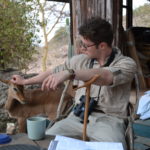
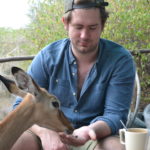
As the sun began to set over the plains we rolled into the dusty drive of Nickson’s farm. In Nickson’s home we were presented with multiple mugs of sweet tea over which we discussed the logistics of the project. With mugs drained our action plan for the next few days had been arranged, with two days set aside for trailing the functionality of the new make of camera traps in the field followed by a three week trail of the full contingent of camera traps in test locations throughout the Athi Kapiti plains. With this in mind we set out with Nickson to set up the first trial camera trap for the coming night.
With camera trap installed along an isolated trail we made our way back to our beds through the warm night. Armed with the most powerful torch Charlie could find on the internet we were able to take the night drive as an opportunity to look for nocturnal species by “eye flashing”. This technique involves shining a powerful light from a moving car, scanning for the eye shine of mammal species produced by reflection from the tapetum lucidum in the eye. We were pleased with the success of this technique, allowing us to spot snoozing wildebeest, springhares (Pedetes surdaster), and our first giraffes (Giraffa tippelskirchi). After a very busy first day in Africa we settled down for some much needed sleep.
Our second day varied dramatically from the first, with the camera traps being left to run for twenty-four hours before being checked in our second meeting with Nickson we had a day to kill. Since we were close to Nairobi the decision was made to take the opportunity to visit the national museum. As a herpetologist I was particularly interested to view the herpetology collections of the museum, representing the most complete record of East African amphibians and reptiles of anywhere in the world. At the museum we were lucky enough to be hosted by the assistant curator of herpetology Victor Wasomgas who was kind enough to show us the collection along with providing a tour of the world famous Nairobi snake park. Following our stay at the museum we set out to make our way back to Nickson’s farm to check the camera traps and join him to celebrate with the whole community his recent graduation and attainment of an undergraduate degree.
Though we left in good time what we didn’t bank on was the Nairobi traffic. Travelling at around three in the afternoon, long before rush hour, we sat in gridlocked traffic for what seemed an eternity. This was not due to any accidents, nor road works, simply representing the normal operations of the capital city’s road system. Though hot and uncomfortable this was by no means a boring experience, giving us a chance to soak up the sights and sounds of Nairobi in all their shouting, beeping glory. After forcing our way through the Nairobi traffic we finally arrived at Nickson’s farm, having missed the festivities we were to arrive just in time to see Nickson before he removed his mortar board and graduation robes. After the meat-eaters in the group were treated to what was left of the ceremonially slaughtered goat we set out to check our trial camera trap, before resetting it for the second trial night. The first trail night was to yield great results, capturing a spotted hyena (Crocuta crocuta) in the night, followed by a passing farmer and his herd the next morning, and a close up of an Impala’s behind in the afternoon. Pleased with our yield we set up our camera trap for the following day to allow us to test the video settings.
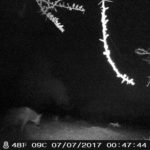
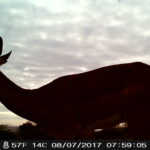
With another day waiting for the results of the camera traps we took the opportunity to visit another local community, the Reachani Maasai of south Athi Kapiti. In this visit we were meeting with six representative of the community to conduct a semi structured interview investigate the issues of human-wildlife conflict faced by the community. This activity not only provided an excellent way for the group to learn about the history and attitudes of the local people as well as the conservation issues they faced, but also provided initial training for us in semi structured interview techniques used by field conservationists to collect qualitative data from communities. To conduct this interview we were directed to a farm were the group was to meet. Unbeknown to us this same farm was hosting a graduation celebration for one of the community members that had recently graduated. As a result we arrived to find the entirety of the Reachani Maasai ready to meet us and ply us with freshly slaughter goat and soda. After finding a quiet spot in the shade we were able to sit down with our focus group and begin our interview with the laughter and music of the celebrations surrounding us. Through our discussion we were to learn about the governance history of the community as it transition from a communally run group ranch to subdivided, settled individual plots of land. We discussed the problems such reorganisation caused local people and the effects such subdivision and enclosement of land had on wildlife migration. Here we were able to direct the conversation to the topic of human-wildlife conflict, allowing us to investigate the changing pressures and responses of the community to predators. After about two hours of discussion we were to bid goodbye to our generous hosts, leaving them to their celebrations.

Returning to our study site we received a call from Nickson informing us that he would not be available to work with us that evening as since we last saw him he was over 150km away with his cattle. As such we took the opportunity to spend the rest of our evening back at base camp, prepping the remaining camera traps for deployment and get an early night for our pre-dawn start the next day to visit Nairobi National Park. Before we retired to bed we set up a single camera trap at the perimeter of our base camp to see what was lurking on the other side of the wall.
Our fourth day in Kenya started many hours before dawn, with the group awaking to the freezing 4:00 am air of Nairobi. Arriving shivering to the gate of Nairobi National Park at 6am we set out into the park. It is a surreal experience to watch the dawn break simultaneously over a capital city and open savanna, the same rays of light bouncing of the glass of sky scrapers and the steaming coats of zebras. Over the course of over six hours in the national park we were to see nineteen different mammal species and over twenty five different species of birds. Particular highlights included both black (Diceros biceros) and white rhinos (Ceratotherium simum) including a calf, hippos (hippopotamus amphibious) and crocodiles (Crocodylus niloticus) basking in pools, and most impressively a trio of lionesses (Panthera leo) attempting to hunt a large male buffalo (Syncerus caffer). With such amazing sights in one of Kenya’s smaller and most urban National Park the whole team was excited to see what the larger and wilder parks hold.
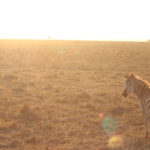
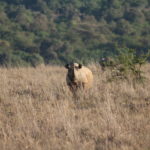
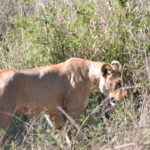
Following a quick lunch after leaving the park it was back to the Athi Kapiti plains for the team to deploy the prepped camera traps in bulk. With six key crossing points identified from the National park into the Empakasi land we set out to deploy traps in each of these regions to trial the effectiveness of long term, large scale camera trap use in information gathering informative in managing human-wildlife conflict. Meeting Nickson at his farm we set off on foot to the deployment sites, trekking along the river that boarders the Nairobi National Park. In setting up the trial conversation meandered to the topic of what to do if we came face to face with a lion on foot. Whilst nonchalantly strapping a camera trap to a tree Enoch imparted his wisdom, stating that one should stand one’s ground if faced with a lion and carry on as normal, the lion usually ignoring you, if a lion is to charge you then there is little you can do, it is simply “a bad day for you”. Baring this wisdom in mind we finished setting up camera traps as the sun set, returning back to base camp for the final time for a few weeks.

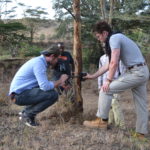
Back at camp we decided to assess the camera trap we had set up the night before, interested to know which of Kenya’s megafauna had set the dog off barking the night before. We were somewhat disappointed to find that the beast that had so terrified the dog was in fact merely other local dogs and a rather lost goat.
Retiring to our beds for the last time in a while in Nairobi we planned to awake the next day to continue our expedition in Amboseli National Park. However, that night we were to change our plans. Word was received from the Maasai Mara that the wildebeest migration had begun, since this globally renowned spectacle may only last for a few days per year we made the last minute decision to change our plans, traveling to the Maasai Mara in the morning to observe this wonder of the world and start our work in the area.
